falter stadtzeitung wien 30.5.07
www.falter.at
sebastian fasthuber
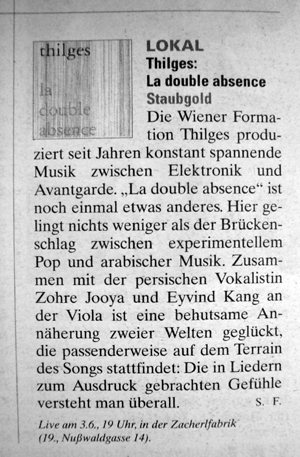
susanna niedermayr
Zeit-Ton, Freitag, 18. Mai 2007, 23:05 Uhr
http://oe1.orf.at/highlights/102922.html
http://www.arte.tv/de/1574018.html
Thilges
„La double absence“
Wenn zwei österreichische „Elektroniker“ sich mit orientalischer
Musik befassen, dann kommt dabei „La double absence“ heraus,
eine subtile „Electroworld“-Scheibe. Keine Zwangsehe, sondern
eine idyllische Begegnung.
Thilges’ CD ist weit mehr als Elektro-Musik, die auf orientalisch
getrimmt wurde, um mehr Pep auf die Tanzfläche zu bringen. Sie besticht
durch ihre Schlichtheit. Den Auftakt bildet "Izdiucz": Der 2003
entstandene Titel gab den Anstoß zu einem ganzen Album, dessen Stil
sich von „Die Offene Gesellschaft“ (dem ersten bei Staubgold
erschienenen Longplayer) abhebt. Die Besonderheit der CD sind bemerkenswerte
Gaststars, wie Zohreh Jooya, eine bekannte Interpretin persischer und
afghanischer Lieder, und der Oud-Virtuose Asim Al-Chalabi. Die Thilges-Köpfe
Gammon und Nik Hummer, die den Umgang mit elektroakustischen und andere
elektronischen Gerätschaften meisterlich beherrschen, sicherten sich
weiterhin die Mitarbeit von Eyvind Kang (einem Violinisten, der in der
Vergangenheit u.a. mit John Zorn für dessen Label Tzadik arbeitete),
Franz Hautzinger (Trompete) und Peter Rosmanith (Perkussion). Die Musik
vereint zahlreiche Elemente, die in den nachdenklichen Stücken und
Improvisationen sparsam dosiert zum Einsatz kommen. Ein politisches Album
(“La double absence“ ist der Titel eines Buchs über Einwanderung
von Abdelmalek Sayad) und ein künstlerisches Wagnis.
Emmanuel Dosda
http://www.last.fm/music/Extrawelt/+journal
3 May 2007, 9:43pm, by acidtongue
www4.fnac.com
Mot de l'éditeur
THILGES (Nick HUMMER et GAMMON) est LE groupe autrichien numéro
1 en terme de musique expérimentale et sophistiquée. Voici
leur nouvel album entre électronica pop et musiques du monde. La
chanteuse persienne ZOHREH JOOYA qui participe à l'album est mondialement
connue sur la scène world & ASIM AL-CHALABI qui a participé
à la composition est le maître incontesté du oud.
LA DOUBLE ABSENCE offre tout ce qu'un album pop peut offrir: mélodies
accrocheuses, rythmes complexes et densité atmosphérique.
LAS Magazine - www.lostatsea.net
Artist: Thilges
Title: La Double Absence
Label: Staubgold
Rating: 8.3 out of 10
It's not often that one comes across
bands from Austria - off the top of my head I can only think of a few
Euro-dance acts from the 1980's and early 90's, and those are rarely considered
to be creators of high quality music. Experimental duo Thilges is however
a different story.
Thilges craft glitchtronica of a very clicky kind; the sounds they use
are razor sharp and clean. On their latest release La Double Absence,
the ensemble have broadened the horizons first glimpsed on Die offene
Gesellschaft in a number of directions. The Austrians employ traditional
instruments like guitar, bass and drums to great effect alongside their
clicks and cuts, but the most remarkable aspect of La Double Absence is
the band's infusion of Middle Eastern influences.
The album is ripe with Arabic and Persian sounds, melodies and voices.
Persian vocalist Zohre Jooya appears on a few tracks, and Asim Al-Chalabi,
master of the lute-like oud, helped pen the album's compositions. "Mehraban
Bash" is a great example of what an excellent little team of collaborators
Thilges put together for La Double Absence. The song rests on an electronic
base, with Arabic strings floating on top, and Jooya's vocals fluttering
in and out throughout the song.
Most of the tracks from La Double Absence are instrumental, and they are
rich and melodic enough to stand with the ones with vocals. The fact that
Persian is a completely foreign language (in every sense of the word)
might contribute to the weight of the instrumental numbers, since the
vocals do not contrast so much as they become another instrument (yeah
yeah, I know, the vocals are always an instrument, but you get my point),
resulting in very lush, beautiful music.
It would do Austria - and the rest of us - a world of good if there were
more bands like Thilges out there, willing to break genre boundaries so
radically and let an entire album be so thoroughly influenced by the music
of a distant culture. Because that is what La Double Absence is, a Middle
Eastern exploration, with some electronica mixed in. Not only does Thilges
forray outside the norm make for great music, it also pushes the boundaries
of what can be done with such disparaging genres and exemplifies how far
such sonic adventurism can take a band's sound. I suppose that Thilges
have truly earned the label of an experimental band, because they dare
trying something new. My hat goes of to them.
Reviewed by Daniel Svanberg
A contributing writer for LAS, Daniel Svanberg now lives in Boston, far
far away from Sweden, where he once lived, although the weather is the
same.
www.hairentertainment.com/music :
Thilges: La Double Absence - Staubgold/Hausmusik/A-Musik ::
If world peace were achieved through the perfect understanding of differences
in music theory and approach, Thilges would be paving the way for a brighter,
better future. La Double Absence is self-described as Western experimental
music meets oriental art music. Persian vocalist Zohre Jooya and renowned
Oud-player Asim Al-Chalabi worked with the Austrian ensemble to bring
together expertise from east, west, now, yesterday and tomorrow. The complex
meolodies, eastern pop hooks, and delicate electronic instrumentation
are as contemporary as they are traditional. Nobel-Peace-Prize 2007. martin
g fuller
www.terz.org (by honker)
THILGES: LA DOUBLE ABSENCE (staubgold) … schließen wir hier
an. Nach "Die offene Gesellschaft" verbindet sich die Österreichische
Band mit dem persischen Sänger Zohreh Jooya, einem versiertem Interpreten
persischer und afghanischer Musik, dem Oud-Großmeister Asim Al-Chalabi
sowie dem US-Avantgarde-Violinisten Eyvind Kang, der schon mit John Zorn
und Mike Patton geigte. Weitere Gäste sind die Austria-Eigenköpfe
Franz Hautzinger und Peter Rosmanith. Das Mastering machte, auch sehr
schön, Patrik Pulsinger. Wir hören zeitlose internationale Musik
der besten Art zwischen Expression, Melancholie, Meditation und Komplexität.
Der Titel ‚Izdiucz' bringt es am besten auf den Punkt: das arabische
Wort beschreibt die Fusion von zwei verschiedenen Materialien und steht
für den Aufbruch kultureller Barrieren. Großartig!
spex 05/07 (by martin hossbach)
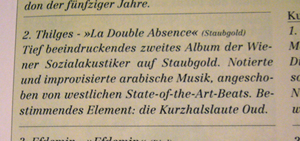
THILGES
La Double Absence [Staubgold]
If ever there is an even balance of cultural worlds, then Austrian experimental
band, Thilges, comes really close to it on La Double Absence, their second
album. Featuring Arabic music set in an electronic experimental context,
this is certainly not Arab lounge music. For a start, the oud playing
by Asim Al-Chalabi is resonant, insinuating and entirely memorable. In
addition, Chalabi had a hand in co-writing all the tracks with Thilges'
Gammon and Nik Hummer. The radio single, Izdiucz, is an apt example where
Chalabi's playing is a potent evocation of traditional Arabic scales.
His quiet, gentle lead-ins increasing to rapid-fire dramatic plucking
is a thrilling example of mysterious sensuality. The inclusion of Iranian
vocalist, Zohreh Jooya, who specialises in Persian and Afghan music, lends
more body to the music. The track, Ayn, shows how Thilges' other-worldly
electronics and programming fills out the subtle textures that Chalabi
plays. Formerly named Thilges 3, the band was also an experimental sound
collective who produced sound installations and performance art.
La Double Absence is filled with complex rhythms. Izdiucz, which means
the breaking of cultural barriers in Arabic, signifies the power of this
album, where two cultures meet and are actually listening to each other.
(8.5) - Philip Cheah
http://www.digitalisindustries.com/foxyd/reviews.php?which=2391
Thilges "La Double Absence"
Staubgold
Combining middle-eastern sounds with glitchy electronics is nothing entirely
new. Sebastian Meissner under his Random Inc. moniker as well as Ran Slavin
already proved that computers and traditional music from the middle east
go well together. And Austria´s Thilges provide another fine example
of how traditional middle eastern music and modern western styles can
benefit from each other.
Compared to Random Inc and Ran Slavin, “La Double Absence”
is quite different though. Less experimental than the two aforementioned
composers, Thilges take traditional Afghan, Persian and Arabic music and
only accompanies them with electronic elements. The center of “La
Double Absence” is the composition and texture. Thilges write songs,
a lot of them with vocals. The vocals are provided by Zohreh Jooya, according
to the label info a well known Afghan singer. Another key player on “La
Double Absence” is Asim Al-Chalab whose Oud playing is central to
the ambiance of most of the songs on the album. Especially the Oud playing
gives them its incredibly dense texture. Thilges are best when the tracks
have enough room to build this texture, like on “Hig” or the
album ender “Hijaz On D”. And Thilges also prove once again
that non-Western music combined with electronics doesn´t have to
sound like all those tacky and bland Chill Out compilations that you hear
at Starbucks all the time. A worthy addition to the Staubgold catalogue.
7/10 -- Stephan Bauer (8 May, 2007)
spex 05/07 (by joachim ody)
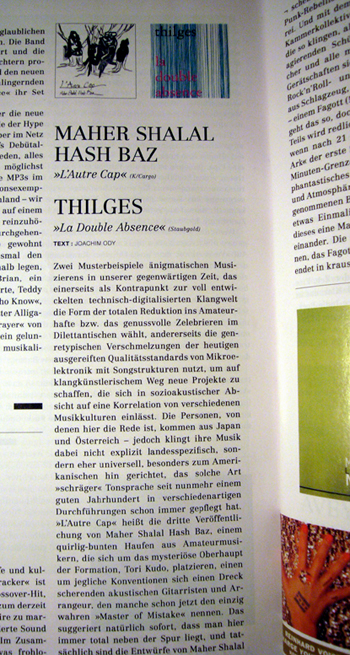
...continue... spex 05/07 (by joachim ody)
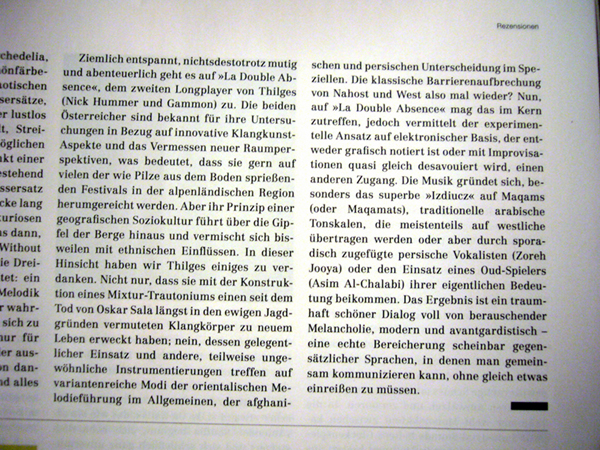
http://shop.vh1.com/La-Double-Absence-Experimental-Rock_stcVVproductId10752875VVcatId424035VVviewprod.htm
Thilges, once known as Thilges 3, was also once known as an experimental
sound collective with an inclination toward sound installation and performance
art. Since the early 2000s, the duo formed by Gammon and Nik Hummer has
been flirting with pop. La Double Absence is the culmination of their
efforts to combine pop appeal, experimental edge, and (for this particular
project) Arab music. Presented as "Western experimental music meets
Oriental art music," La Double Absence is actually more Oriental
than Western in sound, and more electro-pop than experimental in style.
All songs have been co-written by Thilges and oud player Asim Al-Chalabi,
plus other contributors on some tracks. The album revolves around Al-Chalabi's
graceful oud and Zohreh Jooya's entrancing vocals. Thilges' electronics
frame these two main voices, alternately enhancing and polluting them.
Violist Eyvind Kang, quarter-tone trumpeter Franz Hautzinger, and percussionist
Peter Rosmanith. The "experimental" aspect of the album resides
in the electronic textures and the overall fusion attempt, but the result
is actually quite accessible, even rather commercial in a World Fusion
way. "Izdiucz," "Mehraban Bash" and "Völkische"
are particularly convincing, pulling together everyone in a united effort
to achieve a new sound. Tucked at the end of the album, "Hijaz on
D" is a less representative highlight: an instrumental jam featuring
an ominous, almost zeuhl-like bass, and Al-Chalabi's wizardry. The production
is occasionally cold, which tends to rob
Jooya's voice of its natural warmth, and the music tends to vanish as
soon as the CD is over, but otherwise, La Double Absence makes a recommendable
album. ~ François Couture, All Music Guide
by soul seduction
After "Die offene Gesellschaft" (staubgold 33 cd/lp, 2002),
"La Double Absence" is thilges' second fulltime release for
Staubgold: Western experimental music meets oriental art music.
The ensemble emerged in 2003, when thilges was commissioned by the renowned
music promoter "Jeunesse" to make a composition. Among others,
the track "Izdiucz" is characteristic for this release: In Arabic,
this term describes the fusion of two different materials, and stands
for breaking up cultural barriers.
Thilges has been one of Austria's standard bands for sophisticated experimental
and electronic music for a long time. The Persian vocalist Zohreh Jooya
is a widely known interpreter of Persian and Afghan music, and Asim Al-Chalabi
who composed the tracks with thilges is regarded as grandmaster of the
oud in the Arabic world. Since 2004, thilges have realised a number of
performances with the American viola player Eyvind Kang; a.o. Kang has
released his music on Tzadik, and he has performed with John Zorn and
Mike Patton.
For "La double Absence" a specific, new way of playing had to
be developed; some pieces are completely notated, others are improvised.
The music is based on magams, traditional Arabic scales, that were assigned
to particular musicians. For this, thilges invited some of Austria's most
approved musicians for guest performances: Franz Hautzinger (Zeitkratzer,
Comforts of Madness) and Peter Rosmanith (Otto Lechner Ensemble) contribute
trumpet and percussion parts. Patrick Pulsinger is responsible for the
mastering of the record.
"La Double Absence" offers everything a good pop record asks
for: catchy melodies, complex rhythms, and a downright atmospheric density.
The music is about bacchanal, melancholic, and difficult situations, thus
simply about life. This is international music; timeless, beautiful, meditative,
and complex.
(text: Heinrich Deisl)
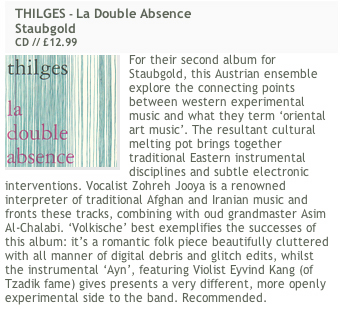
skug 05/07 (by alfred pranzl)

Jan Willem Broek | 19 april 2007 om 21:17
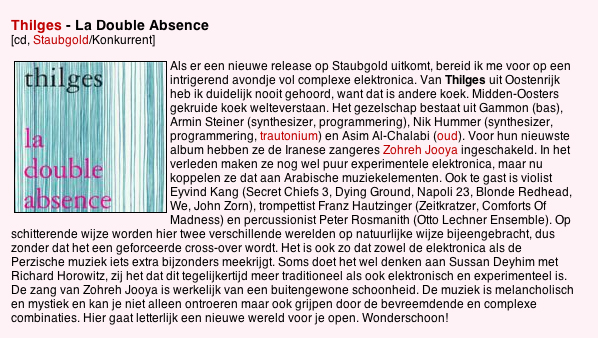
"la double absence" - thilges
“Multikul is flauwekul” lieten onze extreemrechtse vrienden
ons in één van hun meer poëtische momenten weten en
helemaal ongelijk hebben ze niet. Maar al te vaak worden vanuit een goedbedoelde
boodschap elementen bij elkaar gegooid die vooral doen verzuchten dat
een zekere eenheid en uniformiteit nog zo slecht niet is.
Want laten we een kat een kat noemen: folkloristische en volkseigen muziek
klinkt gewoon kut en wanneer die gekoppeld wordt aan een rockidioom is
het zelfs helemaal huilen met de pet op. Vaak genoeg moeten exotische
invloeden zelfs een schrijnend gebrek aan eigen ideeën verdoezelen,
zodat ieder weldenkend mens er gaarne met een boog omheen loopt.
De Oostenrijkse zonderlingen van Thilges (Gammon en Nick Hummer) presteren
niet het onmogelijke maar leveren wel een verdienstelijke poging om het
tij te keren. Op La double absence vermengen ze hun gebruikelijke experimentele
electro met Afghaanse en Arabische invloeden zonder echt belerend of slaapverwekkend
over te komen. Maar ondanks de goedbedoelde statements over culturele
barrières die doorbroken dienen te worden, klinkt het album nergens
écht vernieuwend of verrassend, en zelfs vrij gewoontjes.
Met dit tweede album voor Staubgold klinkt de groep echter wel verrassend
poppy en toegankelijk. De basis voor de nummers werd dan ook gezocht in
Arabische liederen die daarna door het duo samen met een rits muzikanten
(Franz Hautzinger, Peter Rosmanith, Eyvind Kang en Armin Steiner) ingespeeld
werden. De twee speciale gasten, verantwoordelijk voor de couleur locale,
zijn hier oud-legende Asim Al Chalabi (een oud is een luitachtig instrument)
en zangeres Zohreh Jooya. Chalabi stond daarnaast samen met Gammon, Hummer
en Steiner in voor het leeuwendeel van de nummers.
In “Izdiucz” (herhaal dat maar eens tien keer snel na elkaar)
is onmiddellijk een prominente rol weggelegd voor Al Chalabi's oud. Ondanks
een veelvoud aan geluiden, brommende hoorns en krakende percussie is de
oud zo dominant dat het nummer geen brug tussen twee werelden weet te
slaan en in een oppervlakkige dialoog blijft steken. De radio-editversie
is nauwelijks een minuut korter en zoekt dankzij Jooya's inbreng nog meer
de oosterse sferen op. Wie geregeld naar Turkse en aanverwante zenders
zapt, zal hier nauwelijks iets nieuws horen.
Met “Hig” mogen vooral de hoorns wat prominenter klinken en
laat Al Chalabi zich tot een iets frivolere melodie verleiden. De melodielijnen
krijgen een “westerse” dynamiek die mooi contrasteert met
de typische klank van de oud, de percussie plaatst zich dan ook terecht
in een ondergeschikte rol. Die bescheiden rol vervult het ook in “Neba'h”
dat zich wel als een heel klassiek nummer aandient, de inbreng van Thilges
is hier dan ook minimaal te noemen. Paradoxaal genoeg, afgaande op de
titel althans, krijgt net in “Oudische” niet Al Chalabi maar
wel de oosters klinkende percussie meer mogelijkheden en is het Jooya
die de sterrol mag vervullen.
Ook het nukkig klinkende “Völkische” geeft aan de gastzangeres
alle kansen, net zoals het op electro-leest geschoeide “Mehraban
Bash”. “Hijaz On D” laat binnen het geheel, op een enkele
opflakkering na, evenwel weinig nieuws horen en moet dan ook de duimen
leggen voor “Ayn”, dat zonder twijfel het hoogste avant-gardegehalte
van het hele album haalt en als enige durft te breken met de brave sfeer
van de andere nummers.
La double absence vindt zijn ontstaansrecht in een project/opdracht maar
slaagt er nergens in de goede bedoelingen en het (wederzijdse) respect
te overstijgen. Thilges sloopt hier geen barrières maar brengt
een verdienstelijk en charmant klinkend oosters album uit, waarbij het
toefje electro alleen tegen de borst van de meest conservatieve liefhebber
van het genre zal stuiten. Deze “multikul” is gelukkig geen
flauwekul maar echt boeiend is het nu ook weer niet, hooguit verdienstelijk.
Jurgen Boel
30 april 2007 www.goddeau.com
debug 05/07 (by bleed)
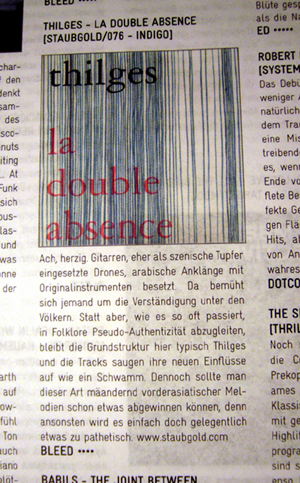
www.squidco.com
Description:"Thilges (sometimes known as Thilges3) are Austrians
Gammon (bass, drums, guitar, electronics) and Nik Hummer (trautonium,
synth, programming) and this is their second full-length release on Staubgold
after their Die Offene Gesellschaft release in 2002. La Double Absence
is Western experimental music meets Oriental art music. The ensemble emerged
in 2003, when Thilges was commissioned by the renowned music promoter
Jeunesse to make a composition. The track "Izdiucz" is characteristic
of this release: in Arabic, this term describes the fusion of two different
materials, and stands for breaking down cultural barriers, and certainly
the guest artists on this recording are emblematic of that. The Persian
vocalist Zohre Jooya is a widely known interpreter of Persian and Afghan
music, and Asim Al-Chalabi who composed the tracks with Thilges is regarded
as grandmaster of the oud in the Arabic world. Also appearing on this
CD is American viola player Eyvind Kang. For La Double Absence a specific,
new way of playing had to be developed; some pieces are completely notated,
others are improvised. The music is based on magams, traditional Arabic
scales, that were assigned to particular musicians. For this, Thilges
invited some of Austria's most approved musicians for guest performances:
Franz Hautzinger (Zeitkratzer, Comforts of Madness) and Peter Rosmanith
(Otto Lechner Ensemble), who contribute trumpet and percussion parts.
Patrick Pulsinger is responsible for the mastering of the record. La Double
Absence offers everything a good pop record asks for: catchy melodies,
complex rhythms, and a downright atmospheric density. The music is about
bacchanal, melancholic, and difficult situations, thus simply about life.
This is international music; timeless, beautiful, meditative, and complex.
Thilges has been one of Austria's standard bands for sophisticated experimental
and electronic music for a long time, and you can see why."-FE
http://audiversity.com/2007/04/new-music-paul-duncanslaraffenland.html
Thilges – La Double Absence / Staubgold
Vienna, Austria has long been a hotbed
for musical innovations. I mean damn, if you look back to the 18th and
19th century the number of classical composers based in or regularly making
appearances in the city is a checklist of now legendary icons in the field
including Mozart, Beethoven, Strauss, Haydn, Schubert, Wagner and on and
on. These days, the classical culture is still rampant with the Burgtheater
being its widely renowned home base, but the most exciting music being
made in the city is actually by its potent avant-garde underground. In
the last twenty years, the experimental electronica scene in particular
has birthed many acclaimed innovators, though the more widely recognized
Berlin underground typically overshadows it. For an example of an innovative
Austrian group, look no farther than Thilges, also known as Thilges 3,
who focus on adding an organic nature to the heavily synthetic electronic
scene. Together since the mid-90s, the core of electronic manipulator
Nik Hummer and multi-instrumentalist Gammon (as well as regular collaborator
Armin Steiner) have set out to infuse the same unpredictable essence of
acoustic instrumentation to the stringent world of programming. To achieve
this they rely solely on analog modular synthesizers, heavily improvised
compositions, a mixture of acoustic instrumentation and electronics and
performing in settings where the music unpredictably interacts with its
surroundings, which result in recordings that are practically impossible
to recreate. For example, they typically perform accompanied by performance
art, in acoustical innovative settings or with a PA system specifically
designed to achieve a different sound depending on your relation to it
(usually a quadraphonic PA system). For their second release on the experimental
German label Staubgold, Thilges were commissioned to combine Western experimental
music with Oriental art and create a geographic-less sound that pulls
influence from many cultures but is grounded in none.
Combining Austrian, American, Persian, Arabic and Afghan cultures with
the grace and refinement of Oriental art, Thilges create a patient, meditative
sound through exotic acoustic instrumentation and an electronic foundation
for La Double Absence. Along for the cause is Persian vocalist Zohre Jooya,
renowned oud player Asim Al-Chalabi, American violist Eyvind Kang and
Austrian musicians Franz Hautzinger on trumpet and Peter Rosmanith on
percussion. The first layer of this nearly indefinable album is the minimal
electronic-based rhythm section. On a Ghostly-like tip of finely chopped
clicks and blips, the loose foundation sometimes augmented with hand percussion
makes for a surprisingly comfortable connection with the acoustic instrumentation
swirling above. Like all Thilges productions, these synthetic sounds are
made solely with analog modular synthesizers like the monophonic trautonium,
an electronic instrument invented in the 1920s most notably utilized in
the soundtrack for Hitchcock’s The Birds. The only other instrument
heard on every song of La Double Absence is Gammon’s acoustic guitar,
which is played in traditional Arabic scales known as magams. This definitely
spins the music in a Middle Eastern direction which is only emphasized
by the resonate, droning tone of the oud. In songs like the opener “Izdiucz,”
Arabic for “a fusion of two different materials,” Hummer seems
to try and match the low tone of the oud with his synths making for an
hypnotizing blend of acoustic and electronic music with boundaries very
much blurred. When Hautzinger adds his subdued trumpet to the mix, a brand
new welcoming sound adds a familiarity to the exotic music; a definite
European or jazz swash to the Middle Eastern foundation. And Jooya’s
sultry Persian and Afghan based vocals heard on about half the songs continue
to bend and blend the cultural boundaries, though I’m slightly partial
to the instrumental numbers.
The most appealing aspect of La Double Absence is its melancholic vibe.
Yes you are mixing a hell of a lot of different sounds, but Thilges keep
it accessible by tastefully layering in a minimal manner. The melodies
though based in foreign scales are recognizably emotional no matter your
geographic home making it truly international music. It also has a very
timeless appeal since the acoustic instrumentation harks back to past
cultures while the electronic rhythms remind you that this could only
be made today. It is a very meditative record in the same sense of some
of the earthy jazz in the early 70s, based in complex melodies that wrap
themselves around your soul and transport the listener into a world only
alive in your mind. La Double Absence is experimental but sophisticated,
exotic but recognizable and chilling but infinitely warm.
Posted by mpardaiolo at 11:33 AM
http://www.vitalweekly.net/567.html
THILGES - LA DOUBLE ABSENCE (CD by Staubgold)
KAMMERFLIMMER KOLLEKTIEF - JINX (CD by Staubgold)
ORGAN EYE (CD by Staubgold)
It's been close to five years since we last reviewed something by Thilges
3, who are now called Thilges, simply because there are more than three
members these days. Originally Thilges 3 started out as an electronic
trio, playing a bunch of doepfer synthesizers, but three years ago, they
suddenly came in disguise as Izdiuzc, with one Asim Al Chalabi on the
Oud and Zohreh Jooya on vocals and now these two are still a member of
Thilges. So the new band name didn't work, and they returned to the 'brand
name' (ho ho) of Thilges. But there are more members to be welcomed such
as Franz Hautzinger, Eyvind Kang and Peter Romanith. The music of Thilges
doesn't sound like anything of the old Thilges 3. An oscillator sweep
can be recognized, or some electronic percussion, but the main music is
played on the oud, viola, trumpet and even vocals. As such this new release
is closer to Izdiucz, but just in case you forgot how that sounded: it
also comes close to the ethnic music, very close, but with a strange electronic
twist. I am not sure what to think of this. Some of the pieces I really
like, but some also sound like a cliche, well, to whatever extent my knowledge
of these musics reach of course, which is not very far. I kind of liked
it, but without knowing exactly why.
Two years after 'Absencen' (see Vital Weekly 461), follows 'Jinx' by Kammerflimmer
Kollektief. After a long and probably tiring tour, the Kollektief is reduced
to three core members, but per track they know how to attract musicians
to play along, so the 'big band' approach is still there. Apparently this
new album is more based on improvisation than before, but the eight pieces
sound as diverse as before. Harking to minimal music, folk, jazz and rock,
Kammerflimmer Kollektief seem to do all, but besides offering a diverse
plate, there is still the 'usual' melancholiac touch to these pieces.
Perhaps it has to do with the instruments such as harmonium, double bass,
cello, piano, lap steel or the wurlitzer, but there overall undercurrent
is melancholy. The best piece is 'Palimpsest', the opening piece, which
sounds like a mellow post rock piece with lovely sustained sounds. Like
before, I like Kammerflimmer Kollektief to a certain extent, but not too
much and not too often.
OK so David Maranha is back. After Osso Exotico's collaboration with Verre
Enharmoniques (see Vital Weekly 557), and a re-issue of 'Piano Suspenso',
he now pops up as Organ Eye, together with Patracia Machas and Jasmine
Guffond and Torben Tilly, otherwise known as Mimit. In February both Maranha
and Mimit played at ZDB in Lisbon and later Machas came along and in between
March and December 2006 they made the two pieces that form the self-titled
debut album. Maranha plays hammond organ, violin, Guffond electronics,
Machas harmonium, bass drum and bowed piano and Tilly electronics. If
one is a bit acquainted with both Osso Exotico and Mimit, it would be
no surprise that drones play an important role here, but it's quite violent
ones. More say Tony Conrad & John Cale than Mirror or Monos. Highly
improvised it seems to me, with lots of small strange sounds shivering
below the surface: the electro-acoustic component of this music. The meeting
of the acoustic instruments by the Portuguese, versus the electro-acoustic,
loop based Australians. It's quite a tour de force this one. Loud, but
not too much noise, present and clear, rather than lulling the listener
into sleep. Very intense music and perhaps for all four involved a break
with what they have been doing so far. For me the best of the these three.
(FdW)
Address: http://www.staubgold.com